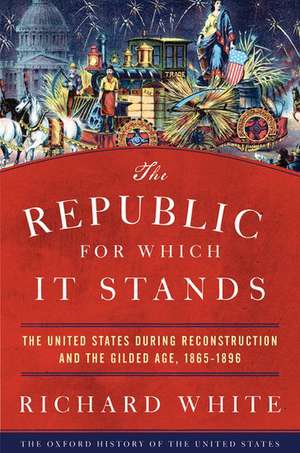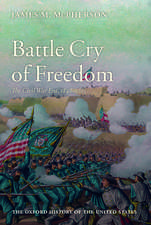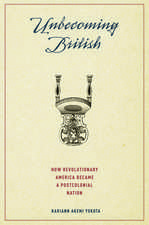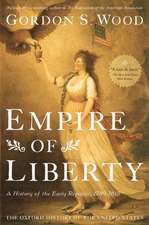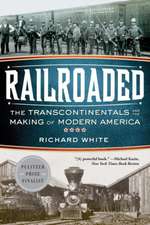The Republic for Which It Stands: The United States during Reconstruction and the Gilded Age, 1865-1896: Oxford History of the United States
Autor Richard Whiteen Limba Engleză Paperback – 14 noi 2019
| Toate formatele și edițiile | Preț | Express |
|---|---|---|
| Paperback (1) | 190.51 lei 3-5 săpt. | |
| Oxford University Press – 14 noi 2019 | 190.51 lei 3-5 săpt. | |
| Hardback (1) | 191.67 lei 10-16 zile | |
| Oxford University Press – 26 oct 2017 | 191.67 lei 10-16 zile |
Preț: 190.51 lei
Nou
Puncte Express: 286
Preț estimativ în valută:
36.46€ • 39.59$ • 30.63£
36.46€ • 39.59$ • 30.63£
Carte disponibilă
Livrare economică 01-15 aprilie
Preluare comenzi: 021 569.72.76
Specificații
ISBN-13: 9780190053765
ISBN-10: 0190053763
Pagini: 968
Ilustrații: 97 halftone images
Dimensiuni: 155 x 229 x 53 mm
Greutate: 1.27 kg
Editura: Oxford University Press
Colecția OUP USA
Seria Oxford History of the United States
Locul publicării:New York, United States
ISBN-10: 0190053763
Pagini: 968
Ilustrații: 97 halftone images
Dimensiuni: 155 x 229 x 53 mm
Greutate: 1.27 kg
Editura: Oxford University Press
Colecția OUP USA
Seria Oxford History of the United States
Locul publicării:New York, United States
Recenzii
Fearless and peerless, Richard White leads us through a transformed and fragmented nation in turmoil, haunted by the slain Abraham Lincoln, where visions of freedom and equality were rapidly vanishing. In the rural South, in the urban North, and out West, from the terribly destitute to the stupendously wealthy, White brings together stories that historians have long told separately, untangling the anger and blame that grew so deeply entrenched in the Gilded Age. How did all this happen? Richard White explains everything.
Richard White has given us a brilliantly imagined narrative of astonishing breadth, thickly peopled with figures from familiar political lions to Lizzie Borden, Dorothy and Toto, that brings to vivid life one of the most challenging periods of American history. His is a twisting, often violent and above all ironic story of a nation finding its way from a time of both tragedy and optimism to one of prodigious wealth and colossal energy, of deepening divisions of class, blood, and ideas, of new meanings of everything from government to geographical space, and of a shaken, tempered faith in the century ahead. This is a masterful performance.
Richard White offers a remarkable new synthesis of the decades following the Civil War, showing the myriad ways in which a period about which most modern Americans know too little in fact laid the foundations for the nation we know today. This book will change the ways we think not just about the past, but about the present as well.
The Republic for Which It Stands illuminates every key aspect of the industrializing, expanding nation in the final third of the nineteenth century: racial, ecological, legal, political, economic, and cultural. In lucid, witty, and often dramatic prose, Richard White makes sense of them all in a way that powerfully echoes the inequalities and environmental degradation of our own day. Yet he also captures the mighty appeal of the developing capitalist economy that was becoming the envy of the world. This is the best book on the Gilded Age that has ever been written.
This is a marvelous achievement of narrative history by a great historian. Written with immense learning, wit, indignation, fearless judgments, and imagination, the book will stand up for a long time as a new vision of two eras with reputation problems. White masterfully weaves the metaphor of the 'vanished twin' through the book and persuasively makes 'home' a central theme binding all Americans of every class or race: as dream, as reality, as racial and gendered place, and as politics. This is not your grandaddy's Gilded Age, although corruption - lots of it - oozes from the story. It is powerful and readable history that exudes all the 'hallmarks of modernity' we have claimed and soberingly invokes our own grave political moment. What 'vanished' is nothing less than the meaning of Union victory and the world the first Republican party struggled to achieve. White is our Mark Twain with archival authority and footnotes.
The Oxford History of the United States continues to surpass expectations with this latest contribution. For many Americans, Reconstruction is still remembered as a period of racial anarchy, political failure, and the humiliation of the defeated South. This volume presents detailed knowledge of what actually happened in the South between 1865 and 1876 and the years that followed. It is sometimes an inspiring but more often deeply shocking story that reveals a nation at its best and worst, when newly freed slaves and idealists, both black and white, struggled to preserve the rights Union armies had won on the battlefield and that Republican members of Congress affirmed in the years after the Civil War.
The conclusion of the Civil War through the 1890s marked the transformation of the US from a rural and agrarian society of free laborers to a modern, urban, industrial nation where wages and possessions replaced liberty and individualism. White's rich, sweeping history chronicles the divide between the Radical Republicans (today's Libertarians) and those who saw the need for governmental protection of individual rights. White seamlessly incorporates political, economic, social, and legal history to show the birth of the modern US. Throughout, he includes fascinating anecdotes that captivate readers. Highly recommended.
The Republic for Which It Stands is a remarkably fresh and innovative way of looking at the Reconstruction and Gilded Age by an academic with unmatched academic credentials. No matter how much you have read on the Reconstruction and the Gilded Age, The Republic for Which It Stands has a lot to offer you. The Republic for Which It Stands should be a required part of any American history syllabus in all universities.
Stanford professor Richard White's The Republic for Which It Stands, a sweeping history of the United States from 1865 to 1896 that just published last month. It's 941 pages but beautifully written and a gripping narrative of a tumultuous era. (White was one of my favorite professors at Stanford. I took two of his classes.)
There is almost nothing about the era that White fails to treat with intelligence and style,,,,Here is the constant American struggle, and Richard White has related a decisive part of its history with stamina and skill.
White's masterful book offers a treasure trove of information about a pivotal time in American history, crafted with a compelling combination of well-written recreations of events and careful analysis based on the latest historical research. The Republic for Which It Stands is the best available guide to the period.
Stanford historian White (Railroaded: The Transcontinentals and the Making of Modern America, 2011) tells this tumultuous story with authority, an eye for detail, and a dash of moral outrage. A noted historian of the West, he covers monetary policy, land use, social history, literature, and biography as he examines America from 1865 to 1896.
The Republic for Which It Stands is a thorough examination of late 19th-century America. White tracks the building of a nation and the growth of its industrial and economic power with an eye toward those left behind by the changes - a welcome focus at a moment when those being left behind by the equivalent changes of our time have just helped spark profound political upheaval by electing President Trump. And even when his analysis tends toward the negative, progressive view of American history, his detail nevertheless enlightens the reader.
In this monumental yet highly readable book, Mr. White has given us a panorama of an age that in many ways seems like our own. The volcanic turmoil of the late 19th century did much to shape the world that we live in today, with its creative and destructive cycles of industry, its quickening technological change, its extremes of wealth and poverty, its struggle to impose fairness in the jungle of the marketplace, its tug of war between freedom and regulation in the public interest. 'The Republic for Which It Stands' is, in no small part, the story of how we came to be who we are.
[White] is one of the outstanding historians of his generation. It is difficult to think of many others who can match the range, depth, originality and influence of his writings, which include a prize-winning account of the construction of the transcontinental railroads, an environmental history of the Columbia River Valley, a general history of the American West, and even a memoir of his mother's life as an emigrant from Ireland.
In his impressive new book The Republic for Which It Stands, the latest volume in the ongoing 'Oxford History of the United States,' White links the Gilded Age with Reconstruction-the two 'gestated together,' he writes-and, in so doing, casts both in a different light while raising new questions about a nation born in the cauldron of civil war.
Winner of the Ellis W. Hawley Prize of the Organization of American Historians
“The Republic for Which It Stands demonstrates White's subtle understanding of a period that may once have been regarded as 'historical flyover country'-and of the American West…..Immigration, industrialization, failures of governance, class conflict and, importantly, the vestiges of Civil War, he shows, dominate and roil this period in ways that shaped the upheavals, inequities, and even the hopefulness, sometimes blinkered, that remain with us today.>
“White's fascinating and comprehensive book could not be more timely....When questions of race, economic inequality, and the rise of giant corporate monopolies and a plutocratic elite dominate U.S. politics, it is time to take another look at Reconstruction and the Gilded Age….Readers will thank White for the clear prose and strong narrative.>
White…is one of the outstanding historians of his generation. It is difficult to think of many others who can match the range, depth, originality and influence of his writings….His footnotes and bibliography reveal a remarkable command of the historical literature, which he uses to construct a vast, sprawling and often original panorama of the American economy, politics and society between 1865 and 1896….White has any number of interesting things to say about any number of subjects, many of them ignored in most books on the period.”-Eric Foner, Times Literary Supplement
“Richard White is well qualified to cover this tumultuous era....He knows as much as anybody about the most important technology of the era. As a professor at Stanford University, he can see the era from the perspective of the west coast as well as the east....White's book should be read-not just because it has so much to say about the latter part of the 19th century, but also because it casts light on America's current problems with giant companies and roiling populism.” -Economist
“White's great achievement is to capture the drabbest, least-redeeming three decades of American history with unimpeachable authority….[and] manages to imbue these ignoble years with the importance that they're due.”-Publishers Weekly (starred review)
Richard White has given us a brilliantly imagined narrative of astonishing breadth, thickly peopled with figures from familiar political lions to Lizzie Borden, Dorothy and Toto, that brings to vivid life one of the most challenging periods of American history. His is a twisting, often violent and above all ironic story of a nation finding its way from a time of both tragedy and optimism to one of prodigious wealth and colossal energy, of deepening divisions of class, blood, and ideas, of new meanings of everything from government to geographical space, and of a shaken, tempered faith in the century ahead. This is a masterful performance.
Richard White offers a remarkable new synthesis of the decades following the Civil War, showing the myriad ways in which a period about which most modern Americans know too little in fact laid the foundations for the nation we know today. This book will change the ways we think not just about the past, but about the present as well.
The Republic for Which It Stands illuminates every key aspect of the industrializing, expanding nation in the final third of the nineteenth century: racial, ecological, legal, political, economic, and cultural. In lucid, witty, and often dramatic prose, Richard White makes sense of them all in a way that powerfully echoes the inequalities and environmental degradation of our own day. Yet he also captures the mighty appeal of the developing capitalist economy that was becoming the envy of the world. This is the best book on the Gilded Age that has ever been written.
This is a marvelous achievement of narrative history by a great historian. Written with immense learning, wit, indignation, fearless judgments, and imagination, the book will stand up for a long time as a new vision of two eras with reputation problems. White masterfully weaves the metaphor of the 'vanished twin' through the book and persuasively makes 'home' a central theme binding all Americans of every class or race: as dream, as reality, as racial and gendered place, and as politics. This is not your grandaddy's Gilded Age, although corruption - lots of it - oozes from the story. It is powerful and readable history that exudes all the 'hallmarks of modernity' we have claimed and soberingly invokes our own grave political moment. What 'vanished' is nothing less than the meaning of Union victory and the world the first Republican party struggled to achieve. White is our Mark Twain with archival authority and footnotes.
The Oxford History of the United States continues to surpass expectations with this latest contribution. For many Americans, Reconstruction is still remembered as a period of racial anarchy, political failure, and the humiliation of the defeated South. This volume presents detailed knowledge of what actually happened in the South between 1865 and 1876 and the years that followed. It is sometimes an inspiring but more often deeply shocking story that reveals a nation at its best and worst, when newly freed slaves and idealists, both black and white, struggled to preserve the rights Union armies had won on the battlefield and that Republican members of Congress affirmed in the years after the Civil War.
The conclusion of the Civil War through the 1890s marked the transformation of the US from a rural and agrarian society of free laborers to a modern, urban, industrial nation where wages and possessions replaced liberty and individualism. White's rich, sweeping history chronicles the divide between the Radical Republicans (today's Libertarians) and those who saw the need for governmental protection of individual rights. White seamlessly incorporates political, economic, social, and legal history to show the birth of the modern US. Throughout, he includes fascinating anecdotes that captivate readers. Highly recommended.
The Republic for Which It Stands is a remarkably fresh and innovative way of looking at the Reconstruction and Gilded Age by an academic with unmatched academic credentials. No matter how much you have read on the Reconstruction and the Gilded Age, The Republic for Which It Stands has a lot to offer you. The Republic for Which It Stands should be a required part of any American history syllabus in all universities.
Stanford professor Richard White's The Republic for Which It Stands, a sweeping history of the United States from 1865 to 1896 that just published last month. It's 941 pages but beautifully written and a gripping narrative of a tumultuous era. (White was one of my favorite professors at Stanford. I took two of his classes.)
There is almost nothing about the era that White fails to treat with intelligence and style,,,,Here is the constant American struggle, and Richard White has related a decisive part of its history with stamina and skill.
White's masterful book offers a treasure trove of information about a pivotal time in American history, crafted with a compelling combination of well-written recreations of events and careful analysis based on the latest historical research. The Republic for Which It Stands is the best available guide to the period.
Stanford historian White (Railroaded: The Transcontinentals and the Making of Modern America, 2011) tells this tumultuous story with authority, an eye for detail, and a dash of moral outrage. A noted historian of the West, he covers monetary policy, land use, social history, literature, and biography as he examines America from 1865 to 1896.
The Republic for Which It Stands is a thorough examination of late 19th-century America. White tracks the building of a nation and the growth of its industrial and economic power with an eye toward those left behind by the changes - a welcome focus at a moment when those being left behind by the equivalent changes of our time have just helped spark profound political upheaval by electing President Trump. And even when his analysis tends toward the negative, progressive view of American history, his detail nevertheless enlightens the reader.
In this monumental yet highly readable book, Mr. White has given us a panorama of an age that in many ways seems like our own. The volcanic turmoil of the late 19th century did much to shape the world that we live in today, with its creative and destructive cycles of industry, its quickening technological change, its extremes of wealth and poverty, its struggle to impose fairness in the jungle of the marketplace, its tug of war between freedom and regulation in the public interest. 'The Republic for Which It Stands' is, in no small part, the story of how we came to be who we are.
[White] is one of the outstanding historians of his generation. It is difficult to think of many others who can match the range, depth, originality and influence of his writings, which include a prize-winning account of the construction of the transcontinental railroads, an environmental history of the Columbia River Valley, a general history of the American West, and even a memoir of his mother's life as an emigrant from Ireland.
In his impressive new book The Republic for Which It Stands, the latest volume in the ongoing 'Oxford History of the United States,' White links the Gilded Age with Reconstruction-the two 'gestated together,' he writes-and, in so doing, casts both in a different light while raising new questions about a nation born in the cauldron of civil war.
Winner of the Ellis W. Hawley Prize of the Organization of American Historians
“The Republic for Which It Stands demonstrates White's subtle understanding of a period that may once have been regarded as 'historical flyover country'-and of the American West…..Immigration, industrialization, failures of governance, class conflict and, importantly, the vestiges of Civil War, he shows, dominate and roil this period in ways that shaped the upheavals, inequities, and even the hopefulness, sometimes blinkered, that remain with us today.>
“White's fascinating and comprehensive book could not be more timely....When questions of race, economic inequality, and the rise of giant corporate monopolies and a plutocratic elite dominate U.S. politics, it is time to take another look at Reconstruction and the Gilded Age….Readers will thank White for the clear prose and strong narrative.>
White…is one of the outstanding historians of his generation. It is difficult to think of many others who can match the range, depth, originality and influence of his writings….His footnotes and bibliography reveal a remarkable command of the historical literature, which he uses to construct a vast, sprawling and often original panorama of the American economy, politics and society between 1865 and 1896….White has any number of interesting things to say about any number of subjects, many of them ignored in most books on the period.”-Eric Foner, Times Literary Supplement
“Richard White is well qualified to cover this tumultuous era....He knows as much as anybody about the most important technology of the era. As a professor at Stanford University, he can see the era from the perspective of the west coast as well as the east....White's book should be read-not just because it has so much to say about the latter part of the 19th century, but also because it casts light on America's current problems with giant companies and roiling populism.” -Economist
“White's great achievement is to capture the drabbest, least-redeeming three decades of American history with unimpeachable authority….[and] manages to imbue these ignoble years with the importance that they're due.”-Publishers Weekly (starred review)
Notă biografică
Richard White is Margaret Byrne Professor of American History at Stanford University. He is the author of numerous prize-winning books, including Railroaded: The Transcontinentals and the Making of Modern America; The Middle Ground: Indians, Empires, and Republics in the Great Lakes Region, 1650-1815; and "It's Your Misfortune and None of My Own": A New History of the American West. He is a recipient of a MacArthur Fellowship, a Guggenheim Fellowship, and a Mellon Distinguished Scholar Award, among other awards.
